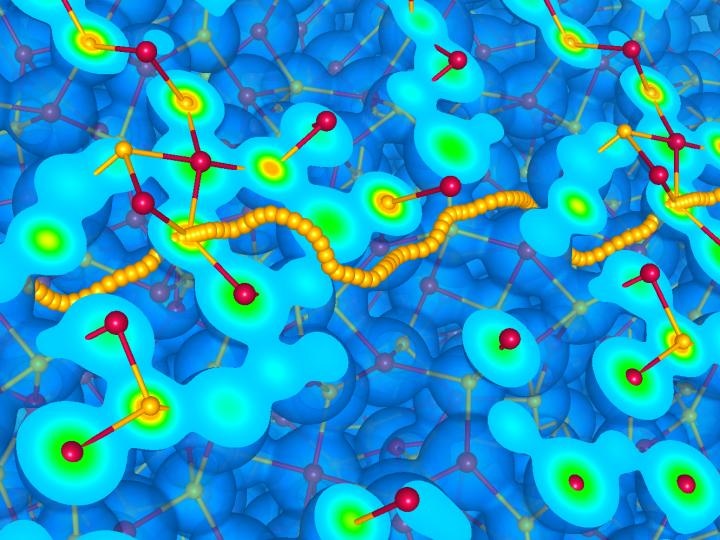Jul 2 2019
Although one would have studied them at school, oxidation numbers have hitherto escaped any rigorous quantum mechanical definition. SISSA researchers reverse this situation by providing a rigorous quantum mechanical description of the concept of atomic oxidation number and apply it to answer an age-old mystery in the physics of ionic conductors, thereby facilitating accurate simulations of a wide group of technologically vital materials.
 Oxidation numbers are defined from the integer charge transported in periodic atomic paths, according to the Thouless theory of charge-transport quantisation. The figure shows a minimum-energy path of a K ion in a model of liquid KCl. (Image credit: Grasselli and Baroni, SISSA)
Oxidation numbers are defined from the integer charge transported in periodic atomic paths, according to the Thouless theory of charge-transport quantisation. The figure shows a minimum-energy path of a K ion in a model of liquid KCl. (Image credit: Grasselli and Baroni, SISSA)
The definition is based on the theory of topological quantum numbers by Thouless, Haldane, and Kosterlitz who were honored with the Nobel Prize in Physics in 2016. This outcome, integrated with recent developments in the theory of transport accomplished at SISSA, enables an accurate, yet tractable, numerical simulation of a wide group of materials that are crucial in planetary sciences and energy-related technologies. The current study has been published in Nature Physics.
All undergraduate students in the natural sciences learn how to link an integer oxidation number to a chemical species participating in a reaction. Regrettably, the very concept of oxidation state has so far escaped a rigorous quantum mechanical definition, so that no technique was identified until now to calculate oxidation numbers from the fundamental laws of nature, let alone show that their use in the simulation of charge conveyance does not lower the quality of numerical simulations. Simultaneously, the evaluation of electric currents in ionic conductors, which is necessary to model their transport properties, is currently based on a complex quantum-mechanical method that rigorously restricts the viability of large-scale computer simulations.
Researchers have recently observed that a simplified model where each atom conveys a charge equal to its oxidation number may deliver results in astonishingly good agreement with rigorous
but costlier approaches. By merging the new topological definition of oxidation number with the so-called “gauge invariance” of transport coefficients, newly discovered at SISSA, Federico Grasselli and Stefano Baroni established that what was considered a simple coincidence stands in fact on solid theoretical foundation, and that the basic integer-charge model captures the electrical transport capabilities of ionic conductors without any approximations.
In addition to solving a central conundrum in condensed matter physics, this result, accomplished within the framework of the European MAX Centre of Excellence for supercomputing applications, also signifies a step forward for applications, allowing computationally achievable quantum simulations of charge transport in ionic systems of paramount importance in energy-related technologies, in the telecommunications and automotive industries, as well as in planetary sciences.
Such applications span from the ionic mixtures accepted in electrolytic cells and heat exchangers in power plants, to solid-state-electrolyte batteries for electronic devices and electric cars, and even to the conducting exotic phases of water happening in the interior of icy giants, which are supposed to be connected to the origin of the magnetic fields in these planets.